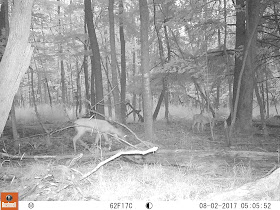 |
| A large caterpillar clasp a Virginia Creeper vine with its fleshy prolegs. |
Yesterday while traipsing through the swamp at Mission Creek Park, I happened to look down at just the right time. Right on the ground, I saw this large reddish brown caterpillar clinging to a Virginia Creeper (Parthenocissus quinquefolia) vine.
 |
| This large caterpillar was about 3 inches long and 3/4 inch across |
I immediately recognized it as a sphinx moth caterpillar, did not know which one. Finding it on a Virginia Creeper helped to identify it; freshly chewed leaves indicated that Virginia Creeper was probably its host species. Knowing a host plant made it relatively easy to look up.
 |
| Pandorus Sphinx caterpillar - a face only a mother (or insect-lover) could love! |
It's a Pandorus Sphinx Moth caterpillar (Eumorpha pandorus). As a larvae, this species feeds on Virginia Creeper and grapes (Vitis spp.). This species is found across the eastern half of the United States. Mid-Michigan is on the northern edge of its range. It is found as far south as the Gulf Coast and west to a line running from eastern Nebraska to eastern Texas. It's range roughly coincides with the range of Virginia Creeper. Pandorus comes from Greek and means "all-giving" or "all-gifted"; the female form of the word is Pandora. In Greek mythology, Pandora is the first woman. In the myth, she opens a jar containing all forms of evil releasing them into the world.
 |
| Pandorus Sphinx caterpillar (head and thorax to upper left) - note white markings on abdomen |
The most distinguishing feature of this caterpillar is the row of white spots on each side of its abdomen. Five of these oval-shaped spots surround spiracles on the caterpillar's abdomen. Spiracles are pores or apertures through which an insect breathes. Insects lack lungs. Instead, oxygenated air enters the insects bodies through the spiracles and passes through a system of tubes known as trachea before entering directly into the insect's body tissues. Gases that are produced in the insect's body pass from the body tissues into the trachea and leave the body through the trachea. Some insects have no control over the flow of gases while others are able to expand and contract abdominal muscles to draw in in or expel air (much like the way we use our lungs).






















































